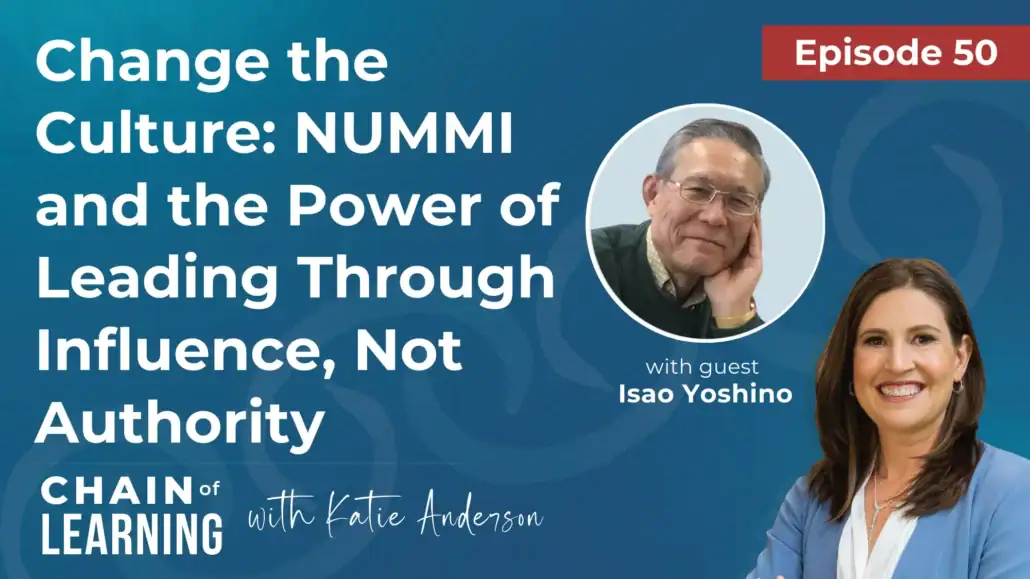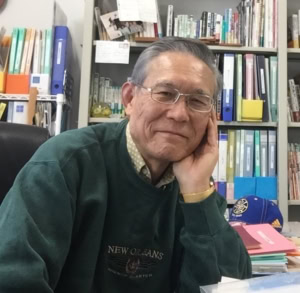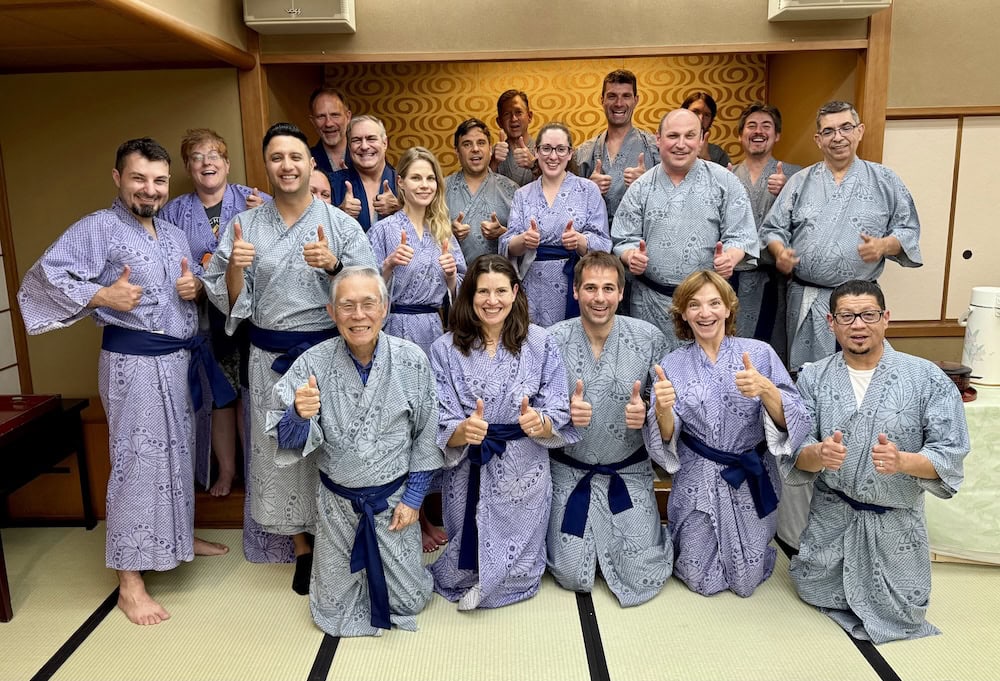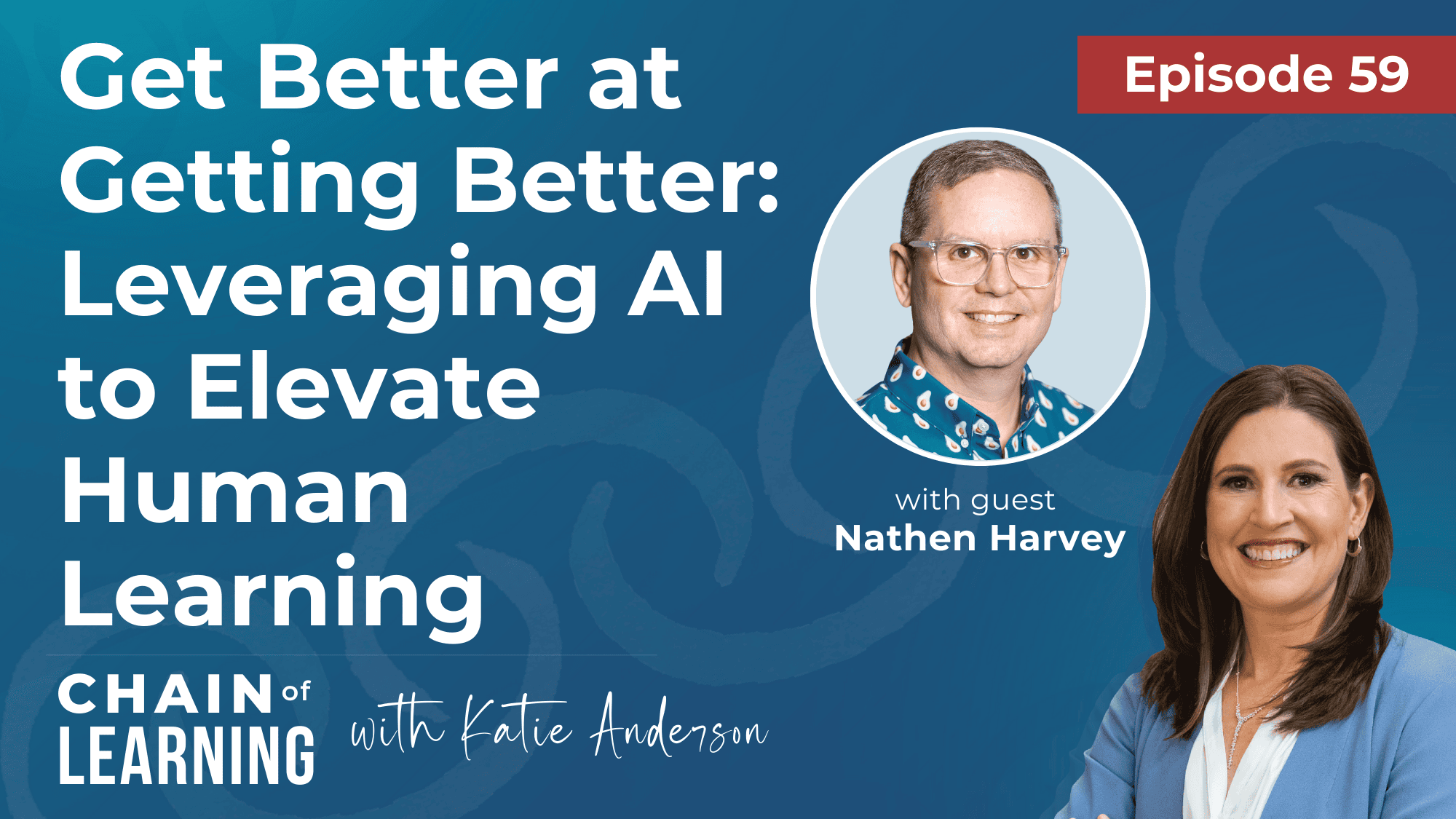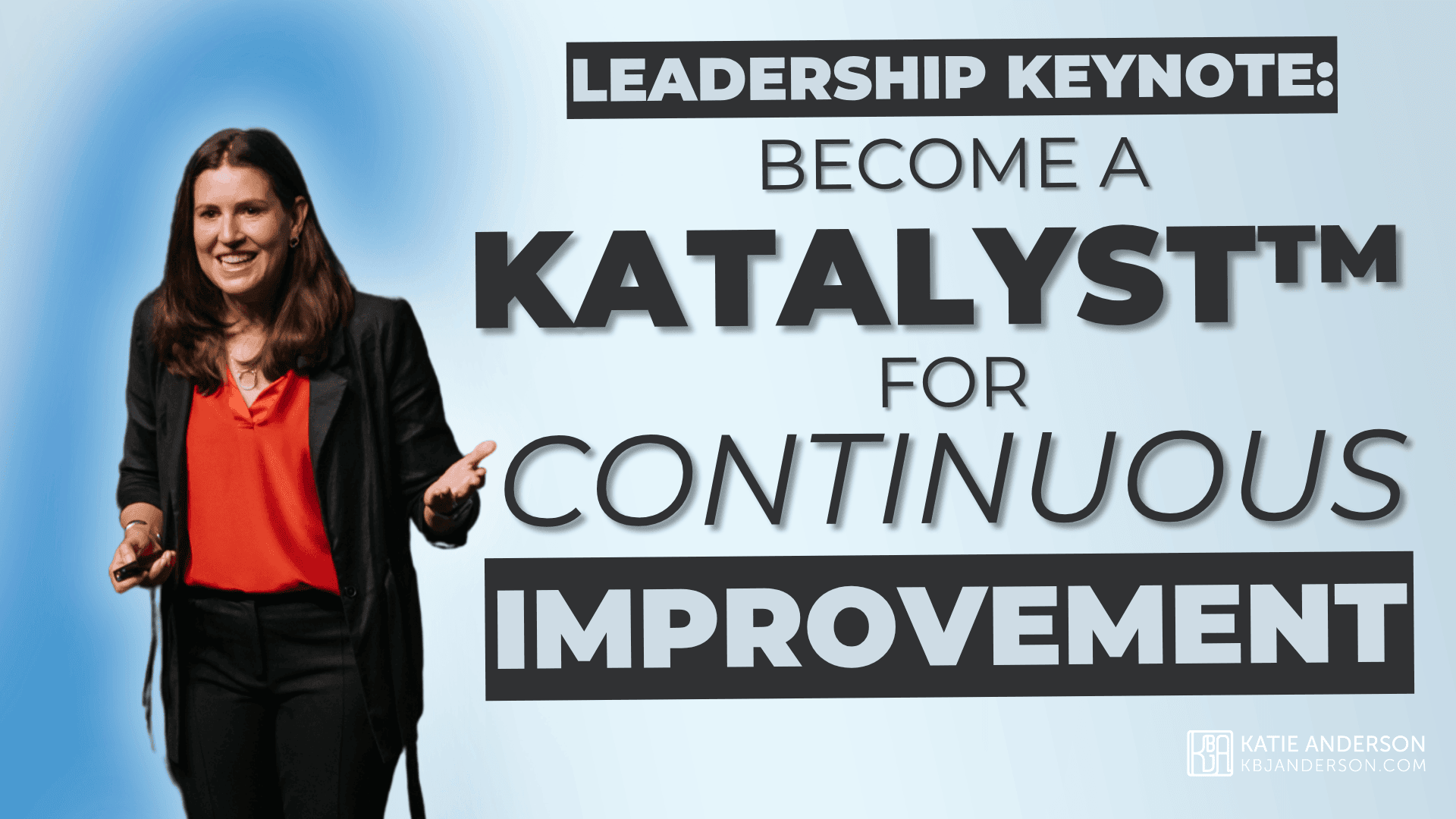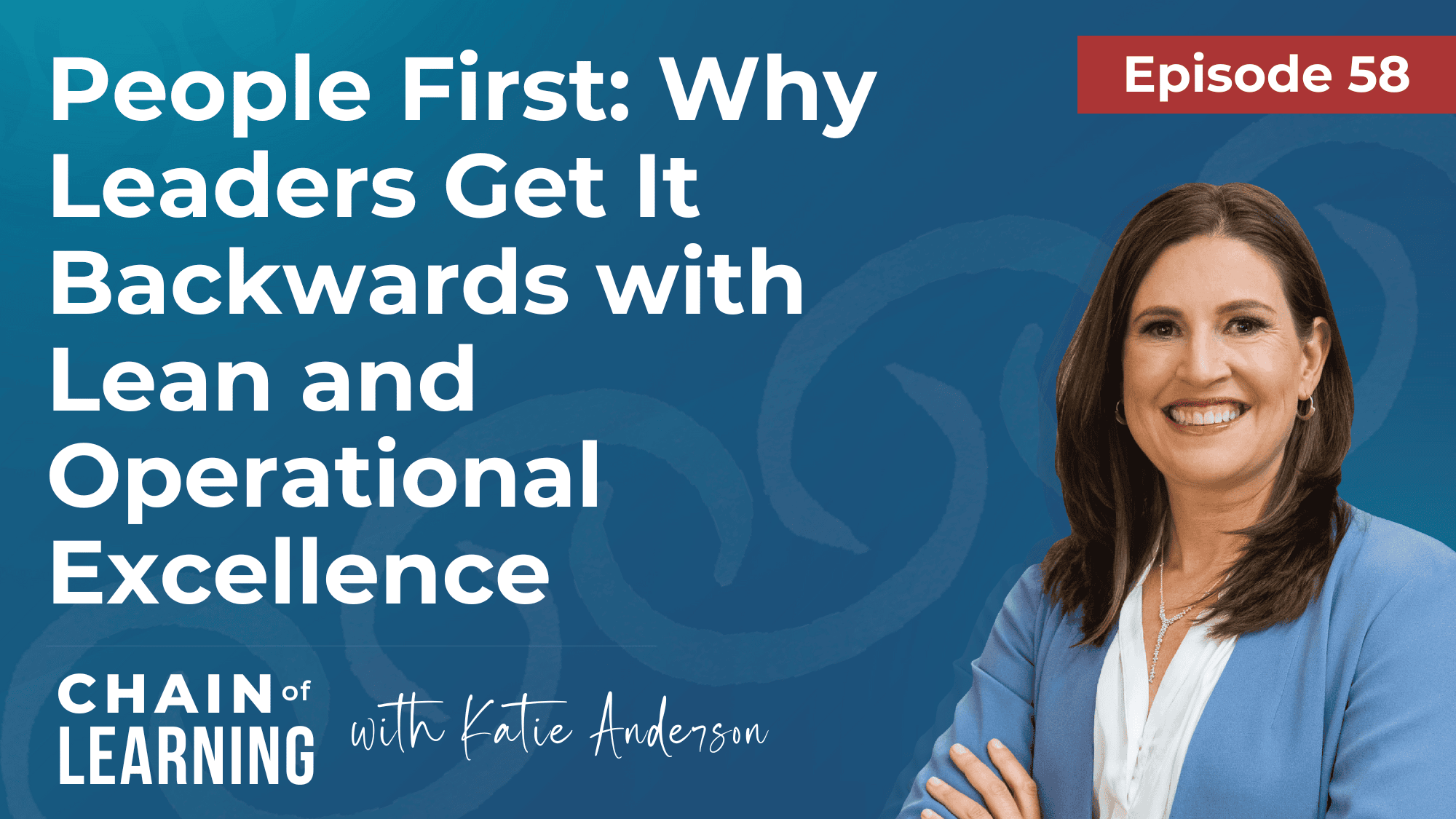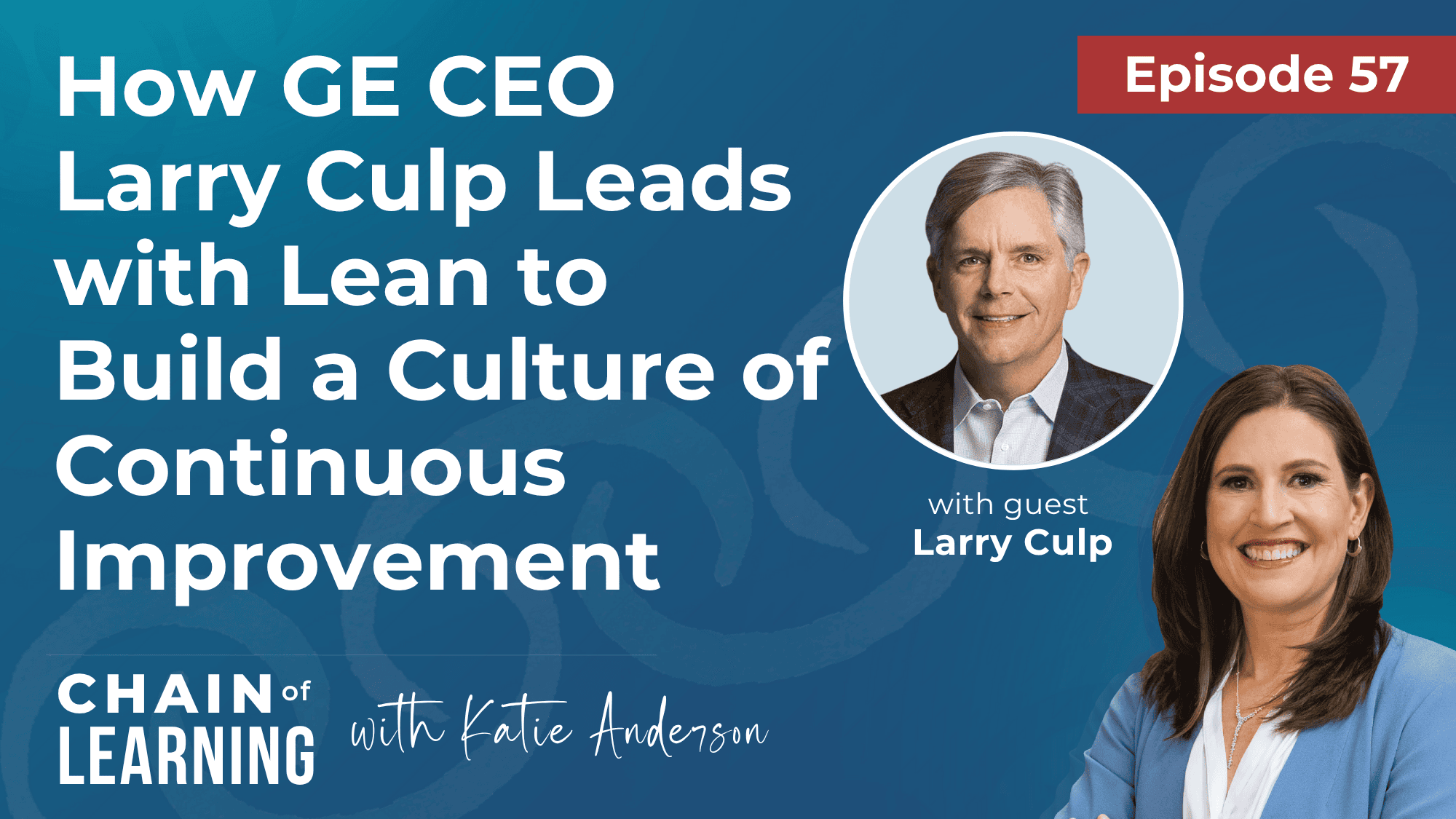What Change Leaders Can Learn From NUMMI
“Change the culture!”
That’s exactly what longtime Toyota leader Isao Yoshino was tasked with during one of the most famous business transformations in history—NUMMI—Toyota’s joint venture with General Motors in the 1980s.
The challenge?
Take GM’s worst-performing plant—plagued by absenteeism, low morale, and poor quality—and turn it around.
Within just one year, with the same American workforce but under Toyota’s leadership, NUMMI became GM’s best-performing site.
Behind the scenes was Mr. Yoshino, leading the design and delivery of a three-week training program in Japan for hundreds of NUMMI’s frontline and middle managers.
In this episode, Mr. Yoshino shares the inside story of NUMMI’s transformation—how an experiment in a business turnaround became a “New Me” moment for its leaders—and the leadership lessons you can use to influence culture change without relying on authority.
In this episode, you’ll learn:
✅ Why you can’t force culture change—and what to do instead
✅ How Mr. Yoshino and his team created immersive learning experiences that shifted NUMMI leaders’ mindsets in just three weeks
✅ Why the “Check” step in PDCA is the secret to Toyota’s sustained success
✅ How the andon process reshaped leaders’ views on problems—and how a “no problem is a problem” and no-blame mindset fosters learning and continuous improvement
✅ Why NUMMI’s transformation was as much (or more) about people as it was about performance
Listen Now to Chain of Learning!
If you are a lean practitioner or change leader curious about how you can “change a culture” —this is your chance to hear the story directly from the person who lived it.
Watch the Episode
Watch the full conversation between me and Isao Yoshino on YouTube.

About Isao Yoshino
Isao Yoshino, worked at Toyota Motor Corporation for over 40 years—from the late 1960s to the early 2000s—and played an important role in the development of Toyota’s people-centered learning culture it’s now famous for.
He was a key part of Kan-Pro senior leadership development program, which embedded A3 thinking as the process for problem-solving, communication, and leadership development across the organization—and has deep expertise in the practice of hoshin-kanri—Toyota’s strategy deployment process.
He’s the subject of my Shingo award-winning book Learning to Lead, Leading to Learn: Lessons from Toyota Leader Isao Yoshino on a Lifetime of Continuous Learning. 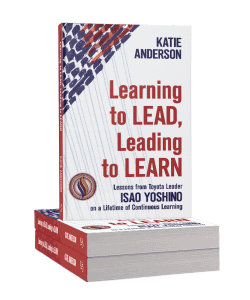
For more stories and behind-the scenes history about the NUMMI joint venture check out my book and jump to Case Study #2: Changing the Culture by Helping People Change – The NUMMI Training Program.
Here’s a snippet from Mr. Yoshino’s account of how he talked with his team to get them on board with a shared understanding of their program’s purpose:
“We decided that we could not set out to change the culture, even though that is what people were expecting us to do. Our training department could not change the NUMMI culture for them. The people who would change the culture were the NUMMI people themselves — not us in Japan. But our training department could help them to change. So, instead, we would focus on how we can help each person learn.”
By every measure, the NUMMI joint venture was a huge success. It changed two companies, created a new one, and provided renewed job satisfaction to hundreds of men and women on two continents. It had, indeed, challenged every participant to become a “new me” for the betterment of the team, and to produce high-quality cars as a result of creating high-quality workers.
Why Mr. Yoshino Joins the Japan Leadership Experience
At the very end of our two hour conversation after we concluded our discussion on leading change through NUMMI and Kan Pro. Mr. Yoshino and I reflected on his experience joining my most recent Japan leadership experience for the full week, our process of recording this podcast and our collaboration and conversations that have spanned over a decade.
“I want [the participants] to learn something from Toyota,” he says, “but I also want to learn myself.” Mr. Yoshino reflects on how the insightful questions from participants push him to think more deeply, how their curiosity sparks his own reflection, and how the experience keeps his mind sharp and spirit young.
This is more than a tour—it’s an immersive leadership learning journey where wisdom is exchanged, not just taught.
Want to be part of this transformational experience?
Join us for the next Japan Leadership Experience—apply now!
Reflect and Take Action
At NUMMI, cultural transformation wasn’t just about processes and systems—it was about people. While NUMMI officially stood for New United Motor Manufacturing Inc., Isao Yoshino often thought of it as “New Me.”
This deeper meaning was about inspiring individuals to become the best version of themselves—equipped with new tools, fresh mindsets, and a renewed approach to leadership.
If you’ve been tasked with “changing the culture,” remember: your greatest impact won’t come from making change happen for others, but from influencing and enabling them to lead the change themselves.
Put it into practice:
- Reflect on the conditions that made cultural transformation possible at Toyota.
- Identify how influence, support, and intentionality show up in your own leadership.
- Consider how you can empower others to take ownership of change.
What’s one way you can create the conditions for others to step into their own “New Me”?
Important Links:
- Check out my website for resources and ways to work with me
- Follow me on LinkedIn
- Download my free KATALYST™ Change Leader Self-Assessment
- For an even deeper behind-the-scenes look at NUMMI, read the dedicated chapter in my book: LearningToLeadLeadingToLearn.com
- NUMMI Documentary
- Episode 47 | Develop Leaders the Toyota Way: Lessons from Kan-Pro with Isao Yoshino
- Episode 22 | Leading to Learn Part 2: The Power of Reflection with Isao Yoshino
- Episode 21 | Leading to Learn Part 1: Build A Chain of Learning with Isao Yoshino
Listen and Subscribe Now to Chain of Learning
Listen now on your favorite podcast players such as Apple Podcasts, Spotify, and Audible. You can also listen to the audio of this episode on YouTube.
Timestamps:
03:02 – How Isao Yoshino felt to be tasked with changing the culture and attitude of NUMMI leaders
04:27 – Creating the space for leaders to experience working in Japan and Toyota’s style
09:21 – Positive results from employees changing their attitude mindset themselves without being forced
12:06 – The importance of “check” in the PDCA process
14:38 – Making the “check” process a positive experience in learning how to improve systems without blame
18:10 – The critical difference between the former GM culture and Toyota with their approach to problems
19:12 – The mindset shift of “no problem is a problem” and the impact of pulling the andon cord
20:19 – The positive results from lettings others learn and grow without force
23:09 – Reflections from Isao Yoshino about being part of the Japan Leadership Experience and continuing to learn something new
24:38 – The acronym for NUMMI and the deeper meaning of, “New Me” to become the best version of yourself
Full Episode Transcript
[00:00:00] Isao Yoshino: Every single day, they are so excited what they saw in the shop floor. Just it’s, it’s amazing. The boss comes down shop floor and they treated us so good. So this is something we never, never expected before. So every single day, their mindsets tend slowly toward more Japanese Toyota style. It’s only two weeks in the soft floor. That is long enough for them to change, which is better.
Katie: Welcome the chain of learning where the links of leadership and learning unite. This is your connection for actionable strategies and practices to empower you to build a people-centered learning culture, get results, and expand your impact so that you and your team can leave a lasting legacy.
I’m your host and fellow learning enthusiast, Katie Anderson. Change the culture. If you’re a leader, coach, consultant, or internal change agent, you’ve likely been given this [00:01:00] mandate before. It can feel daunting, even impossible. That’s exactly what Isao Yoshino subject of my Shingo award-winning book “Learning to Lead, Leading to Learn” was tasked with multiple times during his 40 year career at Toyota.
As he discovered real impact as a change leader doesn’t come from owning the change yourself, but from creating the conditions for others to own it. I invited Mr. Yoshino back to Chain of Learning to explore two pivotal experiences in which he helped shape and expand Toyota’s leadership culture, not from a position of formal authority, but as a trainer, an internal change leader working through influence.
The first which we explored in episode 47 was a two year leadership development initiative called Kan-Pro. The program focused on strengthening senior leaders’ capabilities to align on priorities, develop their people, and improve processes through problem solving. In this episode, we turn to a second major inflection point in Toyota’s history.
Its expansion into global production and the creation of NUMMI, the joint venture between Toyota and General Motors in the mid 1980s. [00:02:00] Located in Fremont, California near where I live, was Toyota’s first overseas production experiment. The challenge proved that the Toyota production system and Toyota Weight leadership culture, what would soon be known globally as lean, weren’t just Japanese things.
And to do so by transforming one of GM’s worst performing plants using the same unionized American workforce. Within a year, their results were extraordinary. The plant once plagued by absenteeism, low morale and poor quality became GM’s top performing plant. And behind the scenes of this cultural transformation, Mr.
Yoshino leading the design and delivery of the training program for NUMMIs Frontline and middle managers. We pick up. Our conversation started in episode 47, recorded just weeks after spending an immersive week together in Japan on my most recent Japan leadership experience. As Mr. Yoshino reflects on what it truly takes to lead cultural transformation through influence not authority, and the critical role in internal [00:03:00] change leaders play in shaping organizational culture.
I began by asking him how it felt to be tasked with changing the culture and attitude of the NUMMI leaders alongside his newly assembled team, including John Shook. Let’s dive back in.
Isao Yoshino: Well, that, that was very, very interesting experience because I was lucky to be, well, not lucky, but I, it was very great experience.
You know what, when I just first received all those, uh, new, new workers and those team leaders level, uh, they were treated so bad and within GM days because the bosses, you know, look down on them. So the relation between boss and someone is terrible, terrible relations. I was a manager in charge of this training program.
I was so stunned. I was so worried about, okay, how can we train them? Uh, uh, the people train those people who come from the potter, different culture, whether, you know, the, the boss and subordinate relations were so [00:04:00] terrible. How can we just succeed in training them? So I, I think a little bit deeper with Josh and, uh, our members.
Then we discuss about what is, what is our target to attain as, as a training team, are we going to, to change the attitude or are what is our, our target to attain? Then, then lots of discussion, uh, take place among us. Then I, I come up with a conclusion that, okay, let’s not try to change their attitude through this three week, only three week training. It’s impossible. However, so we cannot change them because they’re working. We just trained only three weeks, but they’re working three 30 years within those terrible culture, so we cannot change it. However, all we can do is that we can, we can show them what we do at Toyota on the soft floor, or what is the relation between both someone we provide opportunity for [00:05:00] them to witness every single day. We put them in the two weeks in the shop floor, just only two weeks, but we put them in, in shop floor working together with the Japanese, uh, their partners and make them decide with which culture they like. Build a style work together, and then there’s no.
No boss and someone, but it’s, uh, it’s very always communicate those type of very close relation, that type of culture. I let them experience go through that culture and make them decide which is better. So my goal as a, as a, a training manager thought, it’s not that we want to change the attitude, but we just, all we can do our target is make them experience.
A hundred percent of what they want to know, they want to hear, they want to see, and make them decide by themselves. That is our [00:06:00] target. Many, many people just, uh, within came to my, to my office and they no congregation of the new, new project. However, you are going to change the attitude. I think it is impossible.
You see, no, I don’t envy you because it’s how can you, it’s only three weeks, two weeks, three weeks. You can change the attitude. So not many, but some people came over to me. Thank you for your comments, but no, no, no. You, you, you mistake. My goal is not to change the attitude. We cannot, we, we cannot, our team cannot do that.
We cannot do that. Only my goal is, is, is to open, provide opportunity for them to learn, to witness to uh, put themselves knee deep in that, in the situation and make them think which is better. Then many of, of the people who came over to, oh, that is your target. It’s not changing the, changing their attitude.
No, no, no. That is not directly, [00:07:00] no, but we provide opportunity because they’re a human being. Nice people. So they make decision, not us. That was a really big argument with me, myself, and others, other managers within, but that was, I was right because, you know, we cannot change the attitude, but we provide.
But they witnessed, can you believe it? Just only two weeks in shop floor. They witnessed everything. They, from eight to five worked together with Japanese, uh, counterpart. They see the managers came in, talked to them so free and so openly, so they, they saw it every night. I just came back from work. Then I, we went to their dormitory and have dinner together and I listened to them that every single day they are so excited what they saw in the shop floor.
Just, it’s, it’s amazing. The boss comes down shop floor and they treat it so good. They treat it as so good. So this is [00:08:00] something we never, never expected before. So every single day their mindsets changes slowly toward more Japanese Toyota style. It’s only two weeks in the so floor, but that is long enough for them to change, which is better.
So, uh, you know, we did not force them to think about it. We just listened to them and, uh, so there’s only. One week and our, our orientation another two weeks, and so only three weeks staying in Japan, but they witnessed by themselves. It’s so powerful. So by at the end of the entire three weeks and, uh, and, and then when, uh, they are ready to go back home.
Then I asked them, each of them, I said, what is, what is your, what is the plan when you come back to Freeman, California? I learned so many things. I want to, I want to learn the great things and just, just learn by my, [00:09:00] by my own initiative. So I’d like to make this happen so that each person, around 30 people, each person have their own target.
30, very positive. It’s small item, a big item does not matter. So what? They are so happy. So it’s amazing. You know, they started. Thinking of changing their attitude mindset by themselves. We did not force them to do. Only thing we did is that we offered opportunity for them and as expect them to change what think about themselves and decide themselves.
Then within then when they came back to America, within a year. So many things have changed dramatically. Absenteeism from 20% to only 2%, and all those qualities the same level as Toyota. So just happen within [00:10:00] 12 months because of their determination of the, what they have witness. So they workers made their decision by themselves.
We did not do, we just I them to experience that. So it’s. It’s amazing experience. So we learned a lesson that if we want them to change their mindset, don’t force them to think our own way. It doesn’t work. Provide opportunity to learn something and let them decide. So that was what really happened to the this amazing experience.
And so probably they learn so many things from Toyota. More importantly. Toyota people, including me, we learn more things than they learn from Toyota. So that is the very, very great benefit for, for the of of that project.
Katie: So many things. Uh, meta learnings on how to develop culture and change culture. You know, I, I love, I, I often say [00:11:00] that our role as change leaders is to create the conditions for learning.
Just as you said, we can’t actually force the learning themselves. People have to do that. But same with Kan Pro and the leaders riding their A3 by themselves, and then these managers crewing through the, you created the conditions for their learning. Exactly. And that’s the real power of like the internal change leaders as well.
Even if you’re not their boss, you can help them have those learning experiences.
Isao Yoshino: Yeah, so we learned, we learned so many lessons out of all those. I’m pro and I NUMMI training, so I learned a lot and, uh, a little bit, a little bit smarter, just a little bit not enough.
Katie: Throughout our discussion about both NUMMI and Kan-Pro here and in episode 47, Mr. Yoshino and I often return to the mindset and mechanisms that support Toyota’s culture of improvement. One of the most critical, taking time to reflect and learn. As Mr. Yoshino says in the [00:12:00] opening of my book, the only secret to Toyota is its attitude towards learning. I asked Mr. Yoshino to share his thoughts on the importance of the check part of the PDCA or plan do check act cycle, and how reflection supports learning and improvement without blame.
In my experience in working with, with global companies is that, you know, around the world outside of Toyota, we don’t spend very much time on the check adjust the, the Hansei and the, and the learning. Tell me more about your experience about why is that, or how, why and how is it that Toyota built that?
Isao Yoshino: That’s, that’s, that’s a good question because, you know, PDCA plan, do check action. The most important many people go plan is the most important thing. We have to create some good plan. Within Toyota, of course it is. However, check PDC check process is the most important thing because when we plan something and put it into practice for PD plan do, but in many, many [00:13:00] cases, so many things happen.
So you, you cannot proceed the project as the originally planned. Sometimes they change. You have to change it sometimes off the road of the, of the railroad or something at a certain timing. We have to check. At a certain timing, whether the, the, what you originally planned when is going through, originally planned or off the rail or need some changes.
And in many cases things are changed so dramatically these days. So you have to check at a certain timing. And so check process is so important and uh, even, even when you are not planning is not so good, but still what you are doing, you can change it anyway. Check processes sometimes in every three months, but still, if it’s, it’s a small process, the mean we have to have some weekly meeting.
Sometime we have to update then. Then we can do some check process again if check, but we have to be careful when we [00:14:00] say check. Check does not mean that we have to find who is fault or whether things are going bad and who is fault. We don’t care. We don’t put, we don’t put much, you know, importance on who did, who failed it or who succeeded, doesn’t matter because blaming somebody doesn’t create anything.
So when process, we always find out, try to find out whether things are going smoothly or not. Sometimes it doesn’t. So what we can do to help this life, to help us to make it back to the normal. So check process is more positive, positive activity, not, not to blame somebody. Check or blame, okay, you failed or you’re too late or something.
We don’t, we don’t do that, so we don’t say anything about it because blaming somebody does not create anything. So check process is more positive meaning, so that’s why [00:15:00] we Toyota, the people would like to have a check, check process, check meeting. We don’t have to worry about tech meeting. If we fail, then it’s a good opportunity for the boss.
I think that I, I, I saw that, that I can finish it within three months, but I cannot. Then boss said, oh, you cannot do that. What is, what was the reason why it’s delayed? Listen, I will listen to him to tell me. Tell me. So both is ready to give us some advice to us because of the delay or something happens.
They don’t start blaming us because. Both is went through the process million times when he was he or she was younger. So ch process is not the negative purpose, but positive purpose within Toyota. That is a huge difference between Toyota Czech with Toyota style and check with other companies. Yeah. And other companies, people try to hide away.
So sometimes, you know, and uh, even though they have some problems, they don’t want to make it open. But [00:16:00] within Toyota Wheel we make. Mistakes. Then we are ready to make it up because we can learn some hint from somebody else. Of course, we feel bad. We, we don’t, we don’t do it in, in originally planned, but, but this boss does not, our boss does not blame.
The slower pace. There should be some reason why this guy is slower. So tech process should, uh, uh, happen more often. E every week, very short period. Every month, every three months, six months. So many people understand that tech meaning is more negative or blame somebody. No, it’s not. We don’t care about who made the mistakes, who are slower pay.
There should be some reason why it’s slower. Why? Why they failed. So within Toyota’s, Toyota’s mindset, always check is most important thing. And then the don’t worry about it. So what huge difference.
Katie: I prefer [00:17:00] the, the change to the word study rather than check. Because oftentimes people think, check, did you do it or not do it?
And then blame or check the box. But when we study. Outta a learning mindset, right? A learn, a more learning mindset. So I like PDSA plan. Do study. I see.
Isao Yoshino: Maybe, maybe. Yeah. So PD, C, check. Check. So what did, what did you say? Instead of checks, study. Study or study. That’s much better. That’s much better. But within, within Toyota Check does not necessarily mean to find out who is twofold.
We don’t care what is the reason why we fail, because nobody wants to make a a mistake intentionally. So the P-D-S-A-P-D-C-A either is, okay. So that behind the concept behind it’s very, very important because we, we make mistakes, and in my case, I make so many, so many mistakes as a third, this, but. Nobody blames me.
Nobody [00:18:00] blaming somebody does not help anybody, and that is one of the key philosophy at Toyota.
Katie: A critical difference between the former GM culture and Toyotas was their approach to problems. As Mr. Yoshino just highlighted, a foundational element of Toyota’s culture is a no blame mindset. One that enables learning, not punishment.
One of the core shifts Toyota wanted NUMMI leaders to experience during their training in Japan was this very mindset how problems are treated and what that means for creating a real culture of continuous improvement. In the old GM environment, problems are often hidden or ignored. At Toyota, problems are surfaced and addressed at the source.
A powerful symbol of this mindset is the, and on a Japanese word, meaning light or lamp, traditionally it referred to a cord that frontline workers pulled when they encountered a problem or needed support. Today it’s usually a button, but the intention remains the same. What matters isn’t just that a worker [00:19:00] signals a problem, it’s that their manager responds.
That act of responding to help reinforces the belief that problems aren’t something to hide. There’s something to solve. Resolve together. I asked Mr. Yoshino to elaborate on how NUMMIs leaders experience the Andon process in Japan and how it helped shift their mindset to embrace the idea that no problem is a problem.
There’s one thing in particular that you shared with me, and that’s also in “Learning to Lead, Leading to Learn”. That was a real difference for these leaders, which was the concept of. The Andon cord and call not only welcoming bad news and challenges they were having, but also the, the, the team leader’s response to that.
So it’s, you know, can you talk about the power of what they experienced by being part of the Toyota culture and how this was really transformational when they returned home to really change as get those amazing results that you [00:20:00] shared.
Isao Yoshino: Now I understand that they are given power to stop the line because they need to produce a good product.
So, uh, they are treated like a human being. They saw it at Toyota, so why not in California? So they themselves decide by themselves. That’s why they created their own culture in the shop floor. We did not force them, we just helped them to grow. Them to, to, to find out. So what, so they, they did that everything by themselves.
It’s amazing. So it’s many people, oh, Toyota has been teaching, uh, new people. We not teaching. They learn. We provide opportunity for them to learn. So they, they learned it and they changed it by themselves. We did not do anything, just, just help them to learn. So that was fantastic experience. And so it, that’s, that’s why, you [00:21:00] know, uh, uh, we are so proud of, uh, of her the working style because we don’t force them to do something but let them decide by themselves.
And, uh, so, uh, that is a kind of a Toyota policy. Always don’t fo force them to do something. Provide opportunity to learn then see what happens. Takes some longer time than other companies, but doesn’t matter. And, uh, so, uh, I’m very, very, very, very proud of being part of Toyota because of that type of culture.
And so that type of at attitude is created within Toyota. It’s never, it’s, it never go away. Yeah. How old you are because a part of my, my, uh, lifestyle.
Katie: The secret that Toyota, as you shared with me, is its attitude towards learning and it’s, and at the tag, you know, the subtitle of our book, “Learning to Lead, Leading to Learn” is Lessons from Toyota Leader is Y [00:22:00] on a Lifetime of Continuous learning and you’re still learning and sharing and growing this chain of learning.
Isao Yoshino: I am so, I am, I’m And so. I’m just doing what you write, what you wrote in the book.
Katie: I’m so grateful. And can you believe it’s five years since the book came out? Oh
Isao Yoshino: my gosh. Oh my gosh.
Katie: It’s really special. And you know, you talked about how at the end of the NUMMI training program with each cohort that came through, you know, you were there to create the conditions for their learning, but they needed to identify what they were going to take home and implement and apply and practice.
And that’s the same mindset I have with, you know, all of the learning and development. Experiences that I, that I create and, and especially the Japan leadership experience that you’re such an integral part of. You know, at the last day, having all of the global participants reflect on what they’ve learned and what are they gonna take back, what are they gonna do differently because they have to be the ones that really take that forward to make the impact.[00:23:00]
Katie: At the very end of our two hour conversation after we concluded our discussion on leading change through NUMMI and Kan-Pro. Mr. Yoshino and I reflected on his experience joining my most recent Japan leadership experience for the full week, our process of recording this podcast and our collaboration and conversations that have spanned over a decade.
Isao Yoshino: Because I can learn something, you can, you can learn something together that also I can learn something out of the question you ask. So that is the power of, of the question, uh, that just makes me feel so young and, uh, that makes me, uh, keep going. And, uh, working clearly with you.
Katie: Well, thank you. I look forward to many more years of us learning together and working together.
Isao Yoshino: I hope so too.
Katie: There’s so much more to the NUMMI story than what we covered here, especially the intentional support in leadership Toyota provided to reinforce the training. Once the NUMMI leaders return to California, you can read more of the behind the scenes stories and leadership [00:24:00] insights about the new ME transformation and “Learning to Lead, Leading to Learn” specifically in case study two.
I’ll also include a link in the show notes to ANHK documentary about NUMMI, which Mr. Yoshino helped translate into English, along with other resources to continue your learning. What Mr. Yoshino realized in leading the NUMMI training program, as he did during Kan Pro, is that internal trainers and coaches can’t own the change yet they can create the conditions for learning so that leaders take ownership of their own growth.
Their Organizational culture, they are the ones that create their culture, and that’s really what NUMMI was all about. Well, the acronym officially stands for New United Motor Manufacturing Inc. Mr. Yoshino often reflects on its deeper and more personal meaning. New me. New me wasn’t just an experiment in teaching Toyota’s methods overseas.
It was about inspiring people to become a new me, the best version of themselves with new tools, new mindsets, and a [00:25:00] new approach to leadership. If you’re in a role where you’re asked to change the culture, whether as a lean coach, HR leader, consultant, or even a senior executive, remember that your greatest impact won’t come from trying to make change happen For others, it will come from influencing and enabling others to lead the change themselves.
As you reflect on this episode and the previous one on Kan-Pro, episode 47, consider the conditions that enabled cultural transformation at Toyota. What inspired those shifts? What role did influence support and intentionality play? I also invite you to take your learning deeper by joining me and Mr. Yoshino in Japan for the next Japan leadership experience. It’s much more than a trip. It’s an immersive leadership development journey designed to expand your mindset and transform your approach to leading change and reconnecting with the heart of what continuous improvement in operational excellence is all about.
Learn more and apply at KBJAnderson.com/JapanTrip. The link is also in the show notes. If you’ve [00:26:00] enjoyed this episode, be sure to follow and subscribe to Chain of Learning on your favorite podcast player or YouTube and share it with a colleague or friend who’s on their own leadership journey and wanting to change the culture of their organization.
Let’s keep strengthening our global chain of learning together. Thanks for being a part of my chain of learning. I’ll see you next time. Have a great day.
Subscribe to Chain of Learning
Be sure to subscribe or follow Chain of Learning on your favorite podcast player so you don’t miss an episode. And share this podcast with your friends and colleagues so we can all strengthen our Chain of Learning® – together.

